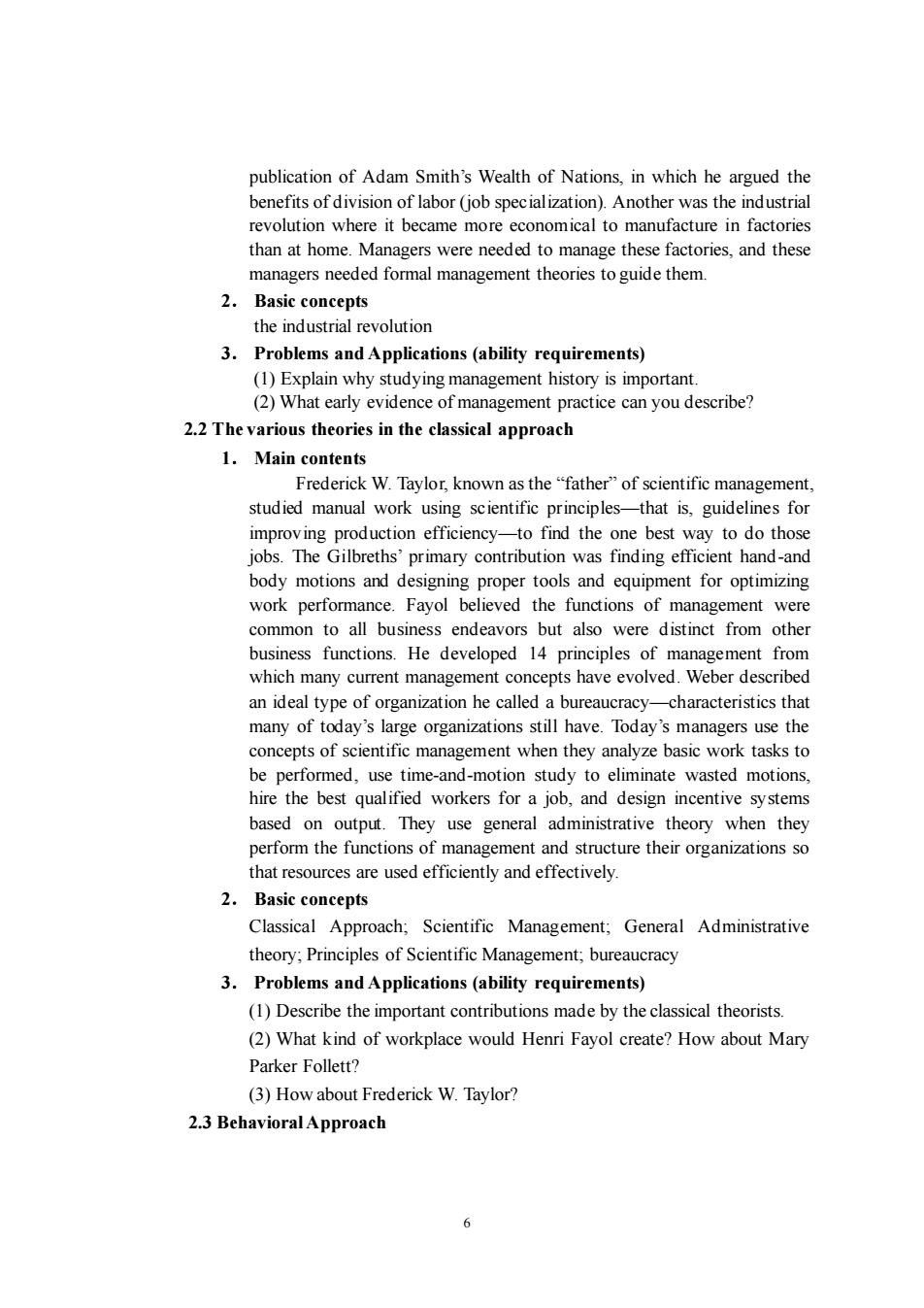
publication of Adam Smith's Wealth of Nations,in which he argued the benefits of division of labor(job specialization).Another was the industrial revolution where it became more economical to manufacture in factories than at home.Manage rs were needed to manage these facto and thes managers needed fo al r management theories to guide them 2.Basic concepts the industrial revolution 3.Problems and Applications (ability requirements) (1)Explain why studying management history is important. (2)What early evidence of management practice can you describe? 2.2 The various theories in the classical approach 1.Main contents studied manual work using scientific principles -that is,guidelines for improving production efficiency-to find the one best way to do those jobs.The Gilbreths'primary contribution was finding efficient hand-and body motions and designing proper tools and equipment for optimizing work nce.Fayol beli ed the function of m mer nt t ag common to all ess endeavors but also were distinct from othe business functions.He developed 14 principles of management from which many current management concepts have evolved.Weber described an ideal type of organization he called a bureaucracy-characteristics that many of today's la organizations still have.Todays manager use the conce ots of scientific management when they ana lyze basic rk tasks to be performed,use time-and-motion study to eliminate wasted motions, hire the best qualified workers for a job,and design incentive systems based on output.They use general administrative theory when they perform the functions of manag nent and structure their organizations tha tresources are used efficiently and effectively 2.Basic concepts Classical Approach:Scientific Management:General Administrative theory:Principles of Scientific Management;bureaucracy 3.Problems and Applications(ability requirements) (1)Describe the important contributions made by the classical theorists. (2)What kind of workplace would Henri Fayol create?How about Mary Parker Follett? (3)How about Frederick W.Taylor? 2.3 Behavioral Approach 6
6 publication of Adam Smith’s Wealth of Nations, in which he argued the benefits of division of labor (job specialization). Another was the industrial revolution where it became more economical to manufacture in factories than at home. Managers were needed to manage these factories, and these managers needed formal management theories to guide them. 2. Basic concepts the industrial revolution 3. Problems and Applications (ability requirements) (1) Explain why studying management history is important. (2) What early evidence of management practice can you describe? 2.2 The various theories in the classical approach 1. Main contents Frederick W. Taylor, known as the “father” of scientific management, studied manual work using scientific principles—that is, guidelines for improving production efficiency—to find the one best way to do those jobs. The Gilbreths’ primary contribution was finding efficient hand-and body motions and designing proper tools and equipment for optimizing work performance. Fayol believed the functions of management were common to all business endeavors but also were distinct from other business functions. He developed 14 principles of management from which many current management concepts have evolved. Weber described an ideal type of organization he called a bureaucracy—characteristics that many of today’s large organizations still have. Today’s managers use the concepts of scientific management when they analyze basic work tasks to be performed, use time-and-motion study to eliminate wasted motions, hire the best qualified workers for a job, and design incentive systems based on output. They use general administrative theory when they perform the functions of management and structure their organizations so that resources are used efficiently and effectively. 2. Basic concepts Classical Approach; Scientific Management; General Administrative theory; Principles of Scientific Management; bureaucracy 3. Problems and Applications (ability requirements) (1) Describe the important contributions made by the classical theorists. (2) What kind of workplace would Henri Fayol create? How about Mary Parker Follett? (3) How about Frederick W. Taylor? 2.3 Behavioral Approach
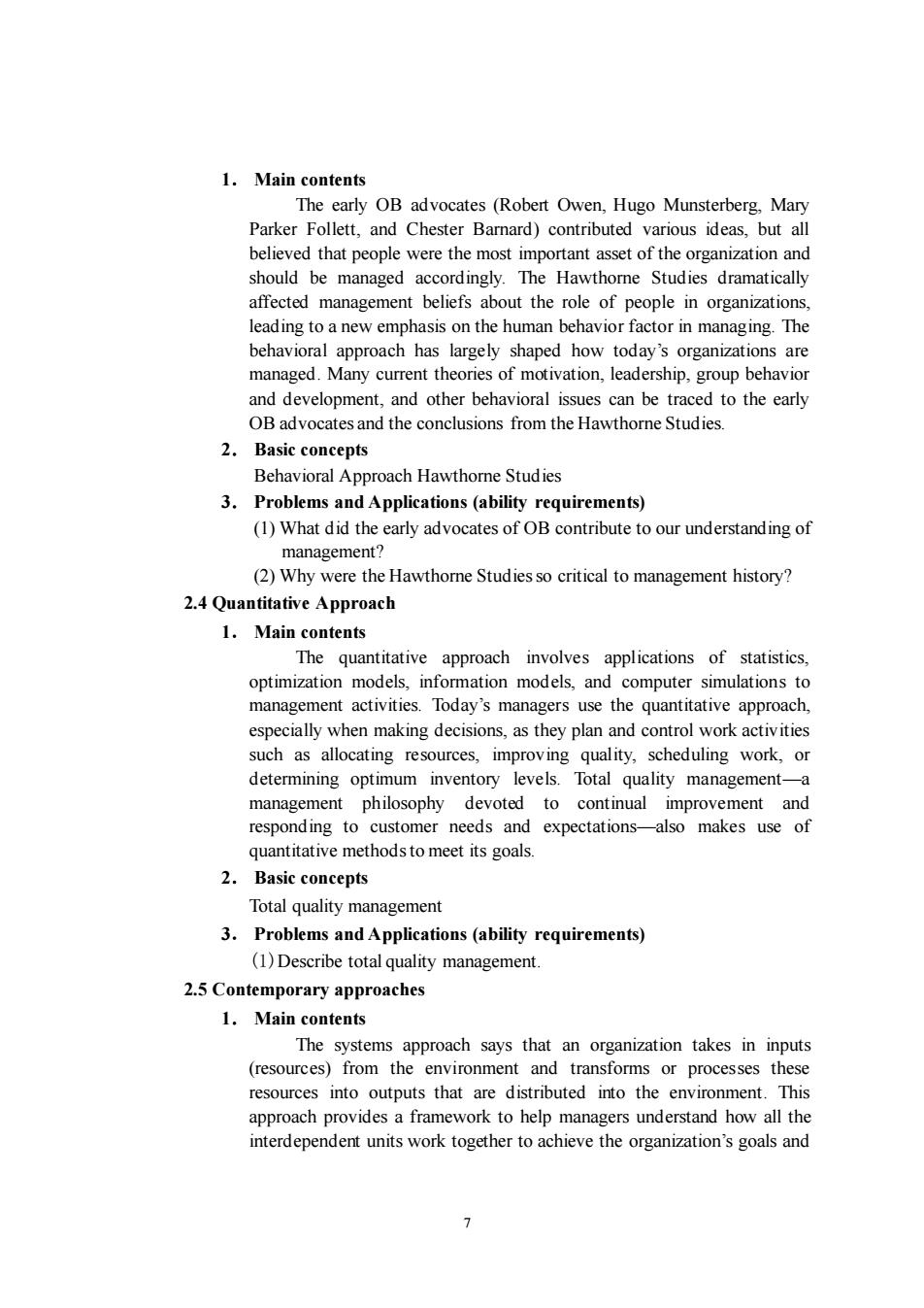
1.Main contents The early OB advocates (Robert Owen,Hugo Munsterberg.Mar Parker Follett,and Chester Bamard)contributed various ideas,but al believed that people were the most important asset of the organization and should be managed accordingly.The Hawthorne Studies dramatically affected management beliefs about the role of people in organizations leading to a new emphasis on the human be factor in ma ging.The behavio approach has largely shaped how ay organiza s are managed.Many current theories of motivation,leadership,group behavior and development,and other behavioral issues can be traced to the early OB advocates and the conclusions from the Hawthorne Studies. 2. Basic concepts Behavioral Approach Hawthorne Studies 3.Problems and Applications(ability requirements) What did the early advocates of OB contribute to our understanding of management (2)Why were the Hawthorne Studies so critical to management history? 2.4 Quantitative Approach 1.Main contents The quantitative approach involves applications of statistics. optimiza ion models models ompu mulations managemen t activi es oday's managers use the quantita tive approach especially when making decisions,as they plan and control work activities such as allocating resources,improving quality,scheduling work,or determining optimum inventory levels.Total quality management-a nt philosophy dev oted to continual mpro ment and respon to customer needs and expectations- -also makes use of quantitative methods to meet its goals 2.Basic concepts Total quality management 3.Problems and Applications(ability requirements) (1)Describe total quality management 2.5 Contemporary approaches 1.Main contents The systems approach says that an organization takes in mpus environment and transforms or processes these resources into outputs that dist ibuted into the environ This approach provides a framework to help managers understand how all th interdependent units work together to achieve the organization's goals and 7
7 1. Main contents The early OB advocates (Robert Owen, Hugo Munsterberg, Mary Parker Follett, and Chester Barnard) contributed various ideas, but all believed that people were the most important asset of the organization and should be managed accordingly. The Hawthorne Studies dramatically affected management beliefs about the role of people in organizations, leading to a new emphasis on the human behavior factor in managing. The behavioral approach has largely shaped how today’s organizations are managed. Many current theories of motivation, leadership, group behavior and development, and other behavioral issues can be traced to the early OB advocates and the conclusions from the Hawthorne Studies. 2. Basic concepts Behavioral Approach Hawthorne Studies 3. Problems and Applications (ability requirements) (1) What did the early advocates of OB contribute to our understanding of management? (2) Why were the Hawthorne Studies so critical to management history? 2.4 Quantitative Approach 1. Main contents The quantitative approach involves applications of statistics, optimization models, information models, and computer simulations to management activities. Today’s managers use the quantitative approach, especially when making decisions, as they plan and control work activities such as allocating resources, improving quality, scheduling work, or determining optimum inventory levels. Total quality management—a management philosophy devoted to continual improvement and responding to customer needs and expectations—also makes use of quantitative methods to meet its goals. 2. Basic concepts Total quality management 3. Problems and Applications (ability requirements) (1)Describe total quality management. 2.5 Contemporary approaches 1. Main contents The systems approach says that an organization takes in inputs (resources) from the environment and transforms or processes these resources into outputs that are distributed into the environment. This approach provides a framework to help managers understand how all the interdependent units work together to achieve the organization’s goals and
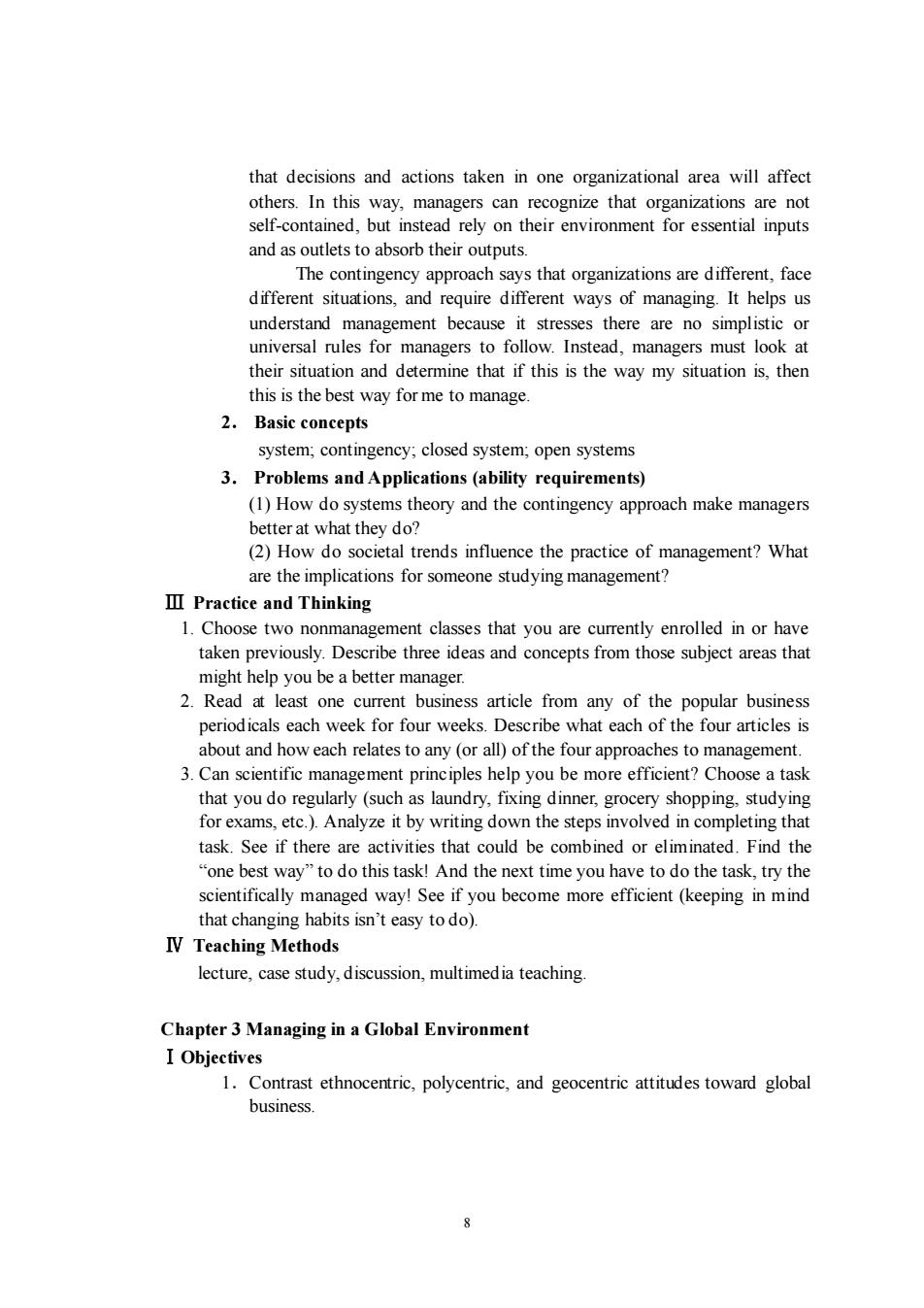
that decisions and actions taken in one organizational area will affect others.In this way,managers can recognize that organizations are not self-contained.but instead rely on their environment for essential inputs and as outlets to absorb their outputs. The contingency approach says that organizations are different,face different situations,and require different ways of managing.It helps us understand management because it stresses there are no simplistic or universal rules for managers to follow.Instead,managers must look at their situation and determine that if this is the way my situation is,then this is the best way for me to manage 2.Basic concepts system,contingency,closed system;open systems 3.Problems and Applications(ability requirements) (1)How do systems theory and the contingency approach make managers b at wha (2)How do soc are the implications for someone studying management? II Practice and Thinking 1.Choose two nonmanagement tclasses that you are curenty enrolled in or have taken previously.Describe three ideas and concepts from those subject areas that might help you be a better manager. 2.Read at least one current business article from any of the popular business mw each of the four articles is ch es to manageme 3.Can scien ific management principles help you be more efficient?Choose a task that you do regularly (such as laundry,fixing dinner,grocery shopping,studying for exams,etc.).Analyze it by writing down the steps involved in completing that task.See if there are activities that could be combined or eliminated.Find the one best way"to do this task!And the next ime yo ou have to do the task. try the scientifically managed way!See if you become more efficient(keeping in mind that changing habits isn't easy to do). IV Teaching Methods lecture.case study.discussion,multimedia teaching. Chapter 3 Managing in a Global Environment I Obiectives 1.Contrast ethnocentric,polycentric,and geocentric attitudes toward globa business
8 that decisions and actions taken in one organizational area will affect others. In this way, managers can recognize that organizations are not self-contained, but instead rely on their environment for essential inputs and as outlets to absorb their outputs. The contingency approach says that organizations are different, face different situations, and require different ways of managing. It helps us understand management because it stresses there are no simplistic or universal rules for managers to follow. Instead, managers must look at their situation and determine that if this is the way my situation is, then this is the best way for me to manage. 2. Basic concepts system; contingency; closed system; open systems 3. Problems and Applications (ability requirements) (1) How do systems theory and the contingency approach make managers better at what they do? (2) How do societal trends influence the practice of management? What are the implications for someone studying management? Ⅲ Practice and Thinking 1. Choose two nonmanagement classes that you are currently enrolled in or have taken previously. Describe three ideas and concepts from those subject areas that might help you be a better manager. 2. Read at least one current business article from any of the popular business periodicals each week for four weeks. Describe what each of the four articles is about and how each relates to any (or all) of the four approaches to management. 3. Can scientific management principles help you be more efficient? Choose a task that you do regularly (such as laundry, fixing dinner, grocery shopping, studying for exams, etc.). Analyze it by writing down the steps involved in completing that task. See if there are activities that could be combined or eliminated. Find the “one best way” to do this task! And the next time you have to do the task, try the scientifically managed way! See if you become more efficient (keeping in mind that changing habits isn’t easy to do). Ⅳ Teaching Methods lecture, case study, discussion, multimedia teaching. Chapter 3 Managing in a Global Environment ⅠObjectives 1.Contrast ethnocentric, polycentric, and geocentric attitudes toward global business
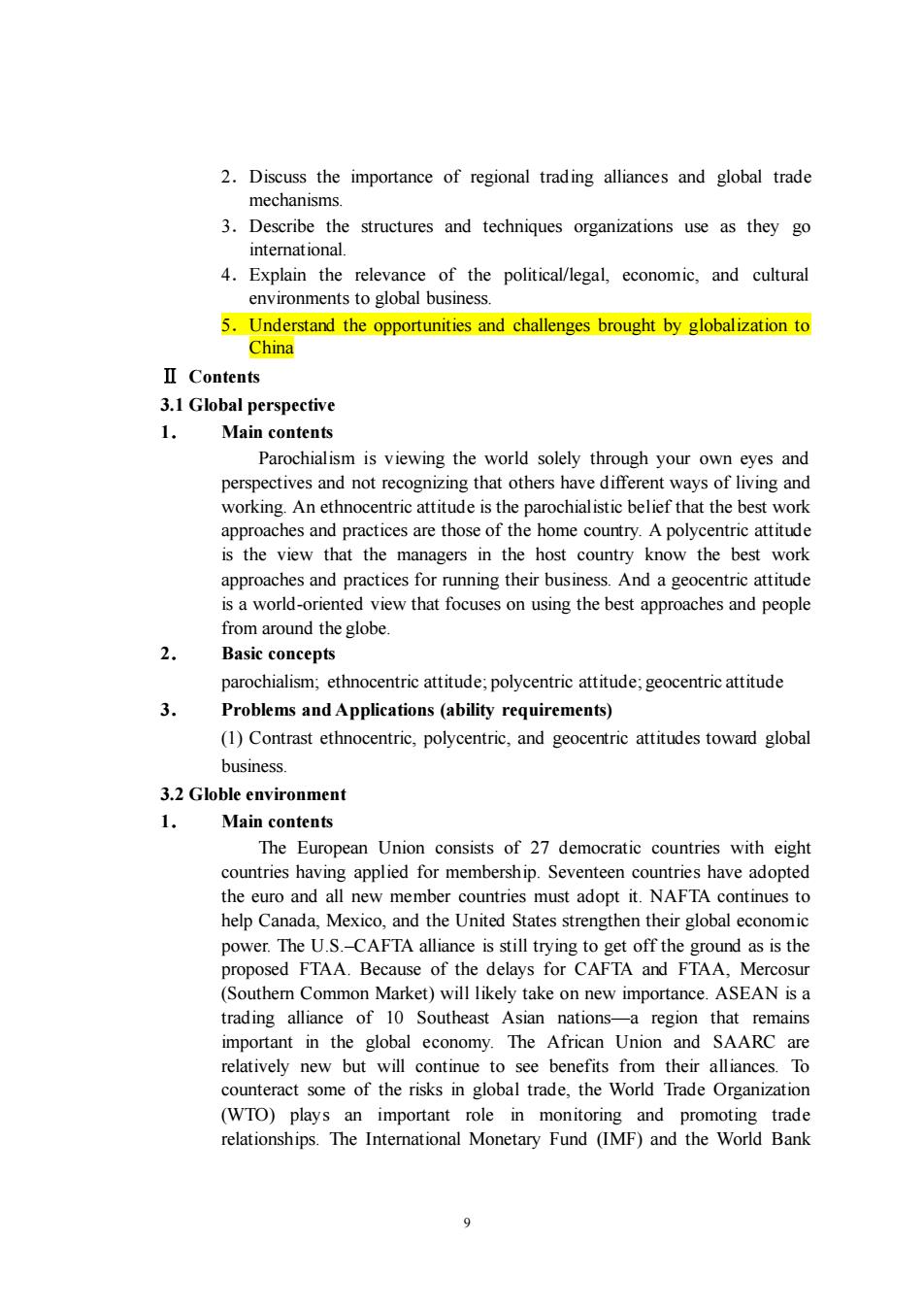
2.Discuss the importance of regional trading alliances and global trade mechanisms 3.Describe the structures and techniques organizations use as they go 4.Explain the relevance of the political/legal,economic,and cultural environments to global business. 5.Understand the opportunities and challenges brought by globalization to China ⅡContents 3.1 Global perspective Main contents Parochialism is viewing the world solely through your own eyes and perspectives and t re that others have ere t ways of living an working.An ethnocentric attitude is the parochialistic belief that the best work approaches and practices are those of the home country.A polycentric attitude is the view that the managers in the host country know the best work approaches and practices for running their business.And a geocentric attitude w that focuses on using the bes t approa and peopl from around the globe Basic concepts 3. Problems and Applications(ability requirements) (1)Contrast ethnocentric,polycentric,and geocentric attitudes toward global business 3.2 Globle environment 1. Main contents The European Union consists of 27 democratic countries with eigh countries having applied r membership.Seventeen countries have adopted the euro and all new member countries must adopt it.NAFTA continues to help Canada,Mexico,and the United States strengthen their global economic power.The U.S.CAFTA alliance is still trying to get off the ground as is the of the delays for CAFTA and FTAA.Merco ommon et)will li likely t take on new importance. ASEAN is a trading alliance of 10 Southeast Asian nations-a region that remains important in the global economy.The African Union and SAARC are relatively new but will continue to see benefits from their alliances.To counteract some of the risks in global trade,the World Trade Organization (WTO) play an importan le in monitoring and relationships.The Interational Monetary Fund (IMF)and the World Bank
9 2.Discuss the importance of regional trading alliances and global trade mechanisms. 3.Describe the structures and techniques organizations use as they go international. 4.Explain the relevance of the political/legal, economic, and cultural environments to global business. 5.Understand the opportunities and challenges brought by globalization to China Ⅱ Contents 3.1 Global perspective 1. Main contents Parochialism is viewing the world solely through your own eyes and perspectives and not recognizing that others have different ways of living and working. An ethnocentric attitude is the parochialistic belief that the best work approaches and practices are those of the home country. A polycentric attitude is the view that the managers in the host country know the best work approaches and practices for running their business. And a geocentric attitude is a world-oriented view that focuses on using the best approaches and people from around the globe. 2. Basic concepts parochialism; ethnocentric attitude; polycentric attitude; geocentric attitude 3. Problems and Applications (ability requirements) (1) Contrast ethnocentric, polycentric, and geocentric attitudes toward global business. 3.2 Globle environment 1. Main contents The European Union consists of 27 democratic countries with eight countries having applied for membership. Seventeen countries have adopted the euro and all new member countries must adopt it. NAFTA continues to help Canada, Mexico, and the United States strengthen their global economic power. The U.S.–CAFTA alliance is still trying to get off the ground as is the proposed FTAA. Because of the delays for CAFTA and FTAA, Mercosur (Southern Common Market) will likely take on new importance. ASEAN is a trading alliance of 10 Southeast Asian nations—a region that remains important in the global economy. The African Union and SAARC are relatively new but will continue to see benefits from their alliances. To counteract some of the risks in global trade, the World Trade Organization (WTO) plays an important role in monitoring and promoting trade relationships. The International Monetary Fund (IMF) and the World Bank
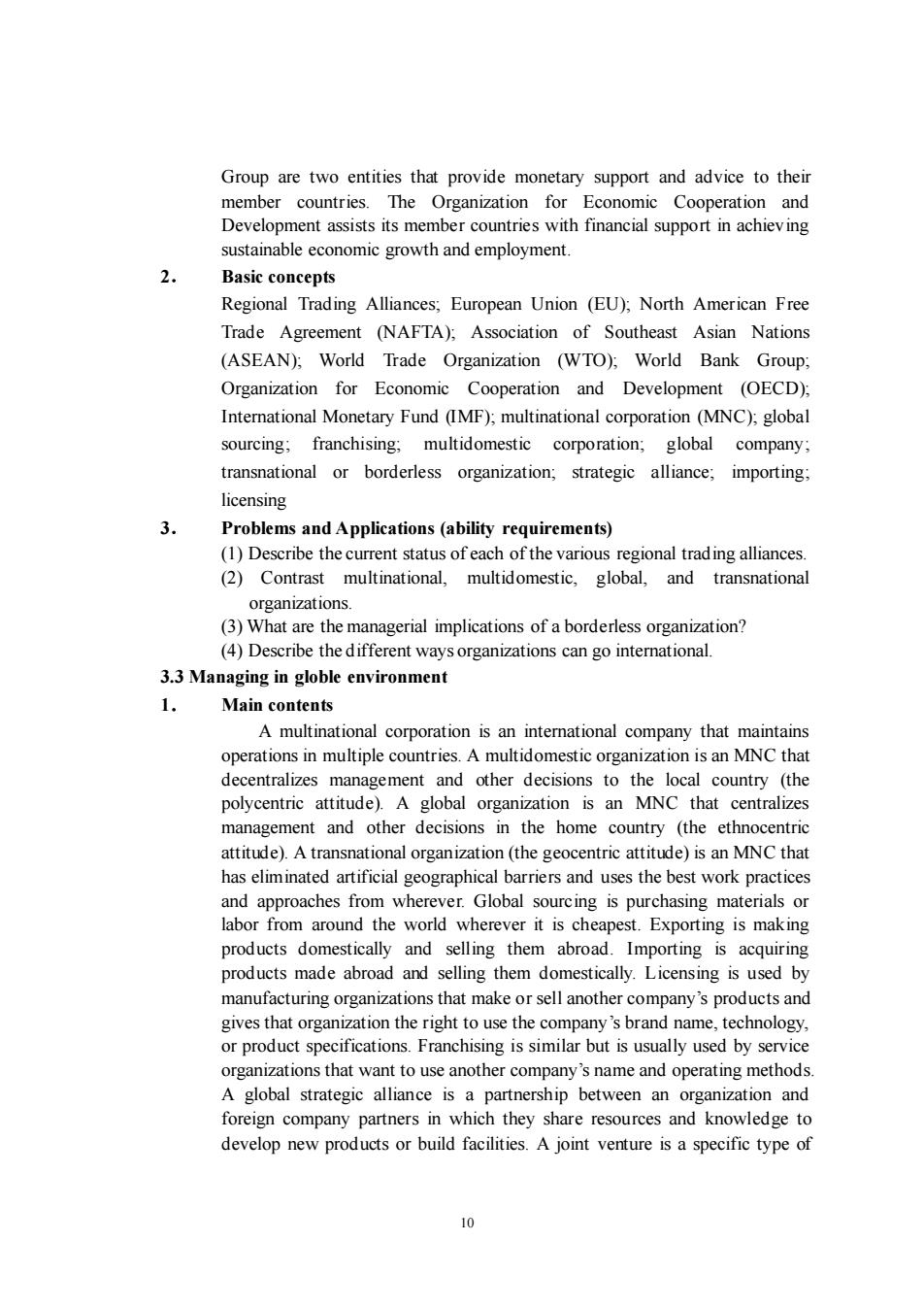
Group are two entities that provide monetary support and advice to their member countries.The Organization for Economic Cooperation and Development assists its member countries with financial support in achieving sustainable economic growth and employment Basic concepts Regional Trading Alliances;European Union (EU);North American Free Trade Agreement (NAFTA):Association of Southeast Asian Nations (ASEAN):World Trade Organization (WTO).World Bank Group Organization for Economic Cooperation and Development (OECD), Intemational Monetary Fund (IMF):multinational corporation (MNC):global sourcing:franchising:multidomestic corporation;global company: transnational or borderless organization;strategic alliance, importing licensing 3 Problems and Applications(ability requirements (1)Describe the current status of each of the various regional trading alliances. (2)Contrast multinational,multidomestic,global,and transnational organizations (3)What are the managerial implications of a borderless org ganization? (4)Describe the different waysorganizations can go international 3.3 Managing in globle environment 1. Main contents A multinational corporation is an international company that maintains operations in multiple countries.A multidomestic organization is an MNC that decentralizes management and other decisions to the local country (the polycentric attitude).A global organization is an MNC that centralizes anagement and othe decision the home country e centr attitude).A transnational organization (the geocentric attitude)is an MNC tha has eliminated artificial geographical barriers and uses the best work practices and approaches from wherever.Global sourcing is purchasing materials or labor from around the world wherever it is cheapest.Exporting is making products d stically nd sell ng them abro d.Imp ing products made abroad and selling them domestically.Licensing is used by manufacturing organizations that make or sell another company's products and gives that organization the right to use the company's brand name,technology. or product specifications.Franchising is similar but is usually used by service ns that want to use another pany's name and ostteg alcer op on and foreign company partners in which they share resources and knowledge to develop new products or build facilities.A joint venture is a specific type of 10
10 Group are two entities that provide monetary support and advice to their member countries. The Organization for Economic Cooperation and Development assists its member countries with financial support in achieving sustainable economic growth and employment. 2. Basic concepts Regional Trading Alliances; European Union (EU); North American Free Trade Agreement (NAFTA); Association of Southeast Asian Nations (ASEAN); World Trade Organization (WTO); World Bank Group; Organization for Economic Cooperation and Development (OECD); International Monetary Fund (IMF); multinational corporation (MNC); global sourcing; franchising; multidomestic corporation; global company; transnational or borderless organization; strategic alliance; importing; licensing 3. Problems and Applications (ability requirements) (1) Describe the current status of each of the various regional trading alliances. (2) Contrast multinational, multidomestic, global, and transnational organizations. (3) What are the managerial implications of a borderless organization? (4) Describe the different ways organizations can go international. 3.3 Managing in globle environment 1. Main contents A multinational corporation is an international company that maintains operations in multiple countries. A multidomestic organization is an MNC that decentralizes management and other decisions to the local country (the polycentric attitude). A global organization is an MNC that centralizes management and other decisions in the home country (the ethnocentric attitude). A transnational organization (the geocentric attitude) is an MNC that has eliminated artificial geographical barriers and uses the best work practices and approaches from wherever. Global sourcing is purchasing materials or labor from around the world wherever it is cheapest. Exporting is making products domestically and selling them abroad. Importing is acquiring products made abroad and selling them domestically. Licensing is used by manufacturing organizations that make or sell another company’s products and gives that organization the right to use the company’s brand name, technology, or product specifications. Franchising is similar but is usually used by service organizations that want to use another company’s name and operating methods. A global strategic alliance is a partnership between an organization and foreign company partners in which they share resources and knowledge to develop new products or build facilities. A joint venture is a specific type of